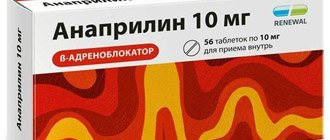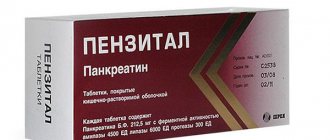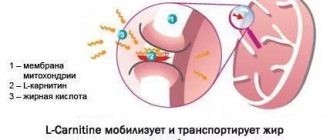Pharmacodynamics and pharmacokinetics
Combined medicinal drug. The main active ingredients are phenobarbital and ethyl bromizovalerianate . Phenobarbital has a vasodilating and sedative effect, and a mild hypnotic effect is noted. There is a decrease in excitation in the central nervous system, sleep occurs faster according to a natural mechanism. Ethyl bromizovalerianate has antispasmodic, hypnotic and sedative effects on the human body.
Is the drug compatible with alcohol?
The metabolism of alcohol and Valocordin occurs in the liver. To neutralize these substances, the same biochemical reactions are used, which occur only in the presence of special proteins (enzymes). Hepatocytes inactivate foreign compounds, preventing their toxic effect on the body.
However, if the liver has to process two substances at the same time, its truss systems are unable to inactivate the entire volume at once. Therefore, the process is delayed, allowing the full spectrum of toxic effects of the drug and ethanol to manifest itself. This mechanism explains the impossibility of compatibility of hangover and phenobarbital in one organism at the same time.
Taking Valocordin against the background of alcoholism leads to side effects of this medication and increased hangover symptoms:
- signs of dysfunction of the gastrointestinal tract (constipation, diarrhea, malabsorption syndrome);
- allergic reactions;
- impaired concentration and reaction speed.
Indications for use of Valocordin
What is the drug prescribed for and for what purpose? Let's consider the following indications for the use of Valocordin.
The medication is prescribed for sinus tachycardia , cardialgia and other forms of functional disorder of the cardiovascular system.
The drug is effective for insomnia, neuroses , irritability, anxiety, restlessness, and a state of excitement, which is accompanied by pronounced reactions from the autonomic nervous system.
Valocordin 20 ml drops for oral administration
Instructions for medical use of the drug VALOCORDIN® Trade name Valocordin® International nonproprietary name No Dosage form Drops for oral use, 20 ml and 50 ml Composition 100 g of solution contains active substances: phenobarbital - 2,000 g, ethyl bromoisovalerate - 2,000 g excipients: mint oil pepper, hop oil, ethanol 96% or 96.5%, purified water. 100 g contains 51 g of ethanol 96%. There are 20 drops in 1 ml. Description Transparent, colorless solution, with the odor of ethyl bromizovalerate and a pungent, bitter aromatic taste. Pharmacotherapeutic group: Hypnotics and sedatives. Sleeping pills and sedatives are different. ATC code N05CM Pharmacological properties Pharmacokinetics Barbiturate is resorbed already in the stomach. Approximately 35% of phenobarbital is bound to plasma albumin. The part not associated with albumin is filtered in the kidneys and, at low pH levels, is reabsorbed. Reverse diffusion does not occur due to the alkalinization of urine. The plasma half-life of phenobarbital is three days. 30% of phenobarbital is excreted unchanged in the urine, while a certain amount (a small amount) is oxidized in the liver. With prolonged use, phenobarbital accumulates in the plasma, as well as enzyme induction in the liver. This induction accelerates the breakdown of the barbiturate. Bromine bound in ethyl bromoisovalerate is excreted from the body very slowly. With prolonged use of the drug, it accumulates in the central nervous system, which leads to the development of bromism. Pharmacodynamics Valocordin® is a combination drug, the therapeutic effect of which is determined by the pharmacological properties of the components included in its composition. Phenobarbital has a sedative and vasodilating effect, and also has a mild hypnotic effect. Helps reduce excitation of the central nervous system and facilitates the onset of natural sleep. Ethyl bromizovalerate has sedative, hypnotic and antispasmodic effects. Peppermint oil has reflex vasodilator and antispasmodic activity. Indications for use - functional disorders of the cardiovascular system (including cardialgia, sinus tachycardia) - neuroses accompanied by irritability, anxiety, fear - insomnia (difficulty falling asleep) - states of excitation accompanied by pronounced vegetative reactions. Method of administration and dosage Valocordin® is taken orally, during meals, with a small amount of water. The dosage and duration of use of the drug is determined individually. Adults are usually prescribed 15-20 drops 3 times a day. If you have difficulty falling asleep, the dose can be increased to 30 drops. There is no experience of use for the treatment of children. Side effects Very rare (<1/10,000) - hypersensitivity reactions (shortness of breath, facial swelling, rash) - Stevens-Johnson syndrome (SJS) - toxic epidermal necrolysis (TEN) Uncommon (> 1/1,000 to <1 /100) - drowsiness, slight dizziness - pain in the stomach and intestines - allergic reactions Not known - reduction in bone mineral density, osteopenia, osteoporosis and fractures in patients who have taken phenobarbital for a long time - development of chronic bromine poisoning (with long-term use of large doses of the drug ), manifestations of which include: depressive mood, apathy, rhinitis, conjunctivitis, hemorrhagic diathesis, impaired coordination of movements. Contraindications: hypersensitivity to any of the components of the drug; severe renal and/or liver dysfunction; pregnancy, lactation; children and adolescents under 18 years of age. Drug interactions When Valocordin® is used simultaneously with sedatives, the sedative effect increases. Simultaneous use with neuroleptics and tranquilizers enhances, and with stimulants of the central nervous system, weakens the effect of each of the components of the drug. Alcohol enhances the effects of Valocordin® and may increase its toxicity. The presence of phenobarbital in Valocordin® can induce liver enzymes, and this makes its simultaneous use with drugs that are metabolized in the liver undesirable, since their concentration and, accordingly, effectiveness will decrease as a result of more accelerated metabolism (indirect anticoagulants, antibiotics, sulfonamides, etc. ) Pharmaceutical preparations containing valproic acid enhance the effect of barbiturates. In combination with coumarin derivatives, griseofulvin, glucocorticoids or oral contraceptives, due to the phenobarbital content in Valocordin®, an accelerated weakening of the effect of the above drugs may be observed as an undesirable interaction. Increases the toxicity of pharmaceutical preparations containing methotrexate. Special instructions With long-term use of the drug, the formation of drug dependence is possible; it is possible to accumulate bromine in the body and develop poisoning with it. Features of the effect of the drug on the ability to drive a vehicle or drive potentially dangerous mechanisms Valocordin®, even when used correctly, may weaken the ability to react quickly. This effect is enhanced by alcohol. In this regard, it is not recommended to drive a vehicle or work with potentially dangerous mechanisms during treatment. Overdose Symptoms: overdose is expressed by intoxication of varying severity. Symptoms of intoxication Acute (mild to moderate) barbiturate intoxication Dizziness, fatigue, even deep sleep from which the patient cannot be awakened. Acute severe intoxication Deep coma, accompanied by tissue hypoxia, shallow breathing, rapid at the beginning, later slowing down. Rapid heartbeat, cardiac arrhythmia, low blood pressure, vascular insufficiency, weak or absent reflexes. If intoxication is not treated, death may occur from circulatory failure, respiratory paralysis, or pulmonary edema. Long-term use of formulations containing bromine can lead to bromine poisoning, which is characterized by the following symptoms: confusion, ataxia, apathy, depressed mood, conjunctivitis, colds, acne or purpura Treatment of intoxication Cases of acute intoxication with Valocordin® should be treated with the same method as and intoxication with hypnotics and barbiturates, depending on the severity of intoxication symptoms. It is necessary to rinse the stomach and take activated charcoal. It is necessary to normalize breathing and blood circulation. Respiratory failure is overcome by artificial respiration, shock by infusion of plasma or substances added to increase plasma volume. If not much time has passed since taking the barbiturate, gastric lavage is prescribed (pour in a solution of two full tablespoons of activated carbon and sodium sulfate). In order to accelerate the removal of barbiturate from the body, forced alkalizing diuresis and hemodialysis and/or hemoperfusion are prescribed. Treatment of bromine poisoning: Large amounts of table salt with simultaneous intake of saluretics accelerate the removal of bromine ions from the body. Release form and packaging 20 ml and 50 ml of the drug are poured into brown glass bottles (hydrolytic class 3), with a vertical polyethylene dropper and a polypropylene screw cap. A self-adhesive label is placed on each bottle. 1 bottle, along with instructions for medical use in the state and Russian languages, is placed in a cardboard pack. Storage conditions Store at temperatures between 15 °C and 22 °C. Keep out of the reach of children! Shelf life: 5 years Do not use after expiration date! Conditions for dispensing from pharmacies Without a prescription Manufacturer Krevel Meuselbach GmbH Krevelstrasse 2 D-53783 Eitorf Germany Owner of the registration certificate Krevel Meuselbach GmbH, Germany Address of the organization accepting claims on the territory of the Republic of Kazakhstan from consumers regarding the quality of products (products) KFK Medservice Plus LLP, Republic Kazakhstan, 050004, Almaty, Mametova street, 54 Telephone/fax Email address
Contraindications
The drug is contraindicated in the presence of hypersensitivity or an allergic reaction to the components of the drug.
Contraindications are severe dysfunction of the liver, kidneys, childhood (up to 18 years), pregnancy, and breastfeeding.
Prescribed with caution for alcoholism, various diseases of the liver, brain, and traumatic brain injury. ethanol content in the preparation .
conclusions
Valocordin brings calm and has the ability to relieve vasospasm. The main active ingredients (phenobarbital and ethyl ester of bromoisovaleric acid) are toxic. However, when following the instructions, the risk of overdose is minimized.
There are such analogues of the drug Valocordin: Valordin, Valoserdin, Valoferin, Corvalol, Lavocordin, Pangluferal. In some of them, phenobarbital is replaced by diazepam.
Valocordin and its substitutes are poorly compatible with a good reaction, so they should not be taken by people in professions that require constant concentration (drivers).
Side effects
Even with long-term use, Valocordin is well tolerated in most cases. Mild dizziness and drowsiness are rarely observed.
Long-term use of the drug in large doses can lead to chronic bromine poisoning . Signs of poisoning: conjunctivitis, rhinitis, depression, hemorrhagic diathesis, disturbances in coordination of movements may be observed. In some cases, skin rashes occur with increased sensitivity. If other reactions occur, you should consult your doctor.
What are the symptoms of a drug overdose?
Even if the instructions for using Valocordin are followed exactly, an overdose of the drug is possible. This depends on the individual level of activity of liver truss systems (the speed of their interaction with foreign substances) and the amount of protein in the blood. Excess Valocordin is manifested by the following symptoms:
- numbness and pathological fatigue;
- restless sleep;
- depressed mood, apathy;
- runny nose;
- conjunctivitis;
- acne on the skin;
- hemodynamic disorders (increased heart rate, hypotension; collapse, shock - fatal complications);
- depression of reflexes and coma.
If the described symptoms appear, you should consult a doctor to adjust the dose or discontinue the drug. If the overdose is so significant that it threatens a person’s life, emergency measures are necessary.
Analogs
Level 4 ATC code matches: Corvalol
Belloid
Corvaldin
Bellaspon
Korvaltab
Bellataminal
Reladorm
Analogues are: Barboval , Valecard , Darvipol , Corvaldin , Corvalol , Corvalcaps , Corvaltab .
Signs of addiction
The following symptoms indicate the development of pathological addiction:
- constant use of drops under any pretext and even in minor stressful situations;
- ritual behavior: a sense of the importance of the action, careful preparation for the reception, priority over other matters;
- a person's inability to sleep or calm down without medication;
- gradual increase in dose, noticeable by the number of bubbles in the first aid kit and in the trash;
- the tendency to create a stock by buying several pieces at once;
- restlessness, depression and irritability when the drug runs out or is unavailable.
Valocordin price, where to buy
The price of Valocordin 20 ml is 130-160 rubles.
50 ml cost approximately 300 rubles.
- Online pharmacies in RussiaRussia
- Online pharmacies in UkraineUkraine
- Online pharmacies in KazakhstanKazakhstan
ZdravCity
- Valocordin drops for internal
approx. 20mlKrewel Meuselbach GmbH RUR 195 order - Valocordin-Doxylamine drops for internal use. approx. 25mg/ml 20mlKrewel Meuselbach GmbH
290 rub. order
Pharmacy Dialogue
- Valocordin (bottle 20ml)Krewel Meuselbach
RUB 195 order
- Valocordin-doxylamine (20ml bottle)Krewel Meuselbach
RUB 266 order
- Valocordin (tab. 7.544 mg + 7.544 mg No. 20) Usolye-Sibirsky Chemical Pharmaceutical Plant/Crevel Moiselbach
140 rub. order
show more
Pharmacy24
- Valocordin 20 ml drops Crevel Meuselbach GmbH, Nimechchina
54 UAH. order - Valocordin 50 ml oral drops Crevel Meuselbach GmbH, Nimechchina
94 UAH order
PaniPharmacy
- Valocordin liquid Valocordin drops 20ml Germany, Krewel Meuselbach
66 UAH order
- Valocordin liquid Valocordin drops 50ml Germany, Krewel Meuselbach
117 UAH. order
show more
Content:
- Story
- Action
- Phenobarbital
- Contraindications and complications
- Consequences of excessive use
- Signs of addiction
- The dangers of addiction
Valocordin is one of the most popular medications used to quickly restore peace of mind and improve heart function. It is sold without a prescription and can be found in almost any medicine cabinet. Meanwhile, it is not as harmless as it might seem. The product contains a serious substance with psychotropic effects - phenobarbital. If you take Valocordin excessively, the consequences can be disastrous, since it is addictive and sometimes provokes serious complications.








